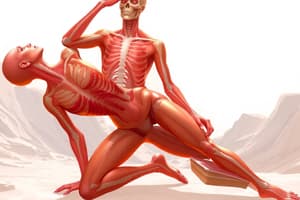Podcast
Questions and Answers
What is the anatomical position characterized by?
What is the anatomical position characterized by?
- Standing with arms at the sides
- Sitting with feet flat on the ground
- Standing upright, facing forward, with palms facing backward
- Standing upright, facing straight ahead, with feet parallel and palms facing forward (correct)
Which plane of motion divides the body into left and right halves?
Which plane of motion divides the body into left and right halves?
- Frontal plane
- Sagittal plane (correct)
- Transverse plane
- Oblique plane
What type of movement occurs in the frontal plane?
What type of movement occurs in the frontal plane?
- Flexion and extension
- Abduction and adduction (correct)
- Hyperextension
- Internal and external rotation
Which axis of rotation corresponds to the frontal plane?
Which axis of rotation corresponds to the frontal plane?
What movements are classified under the transverse plane?
What movements are classified under the transverse plane?
In which position do all joints align at 0° except for the ankle which is at 90°?
In which position do all joints align at 0° except for the ankle which is at 90°?
What is the primary action of lateral flexion?
What is the primary action of lateral flexion?
What does the movement of eversion refer to?
What does the movement of eversion refer to?
Flashcards
Anatomical Position
Anatomical Position
The anatomical position is a standardized reference point for describing body parts and movements. It involves standing upright, facing forward, feet parallel and close, and palms facing forward.
Fundamental Position
Fundamental Position
The fundamental position is similar to the anatomical position, but the arms are at the sides and facing the body.
Sagittal Plane
Sagittal Plane
The sagittal plane divides the body into left and right halves; movements in this plane are flexion, extension, and hyperextension.
Frontal Plane
Frontal Plane
Signup and view all the flashcards
Transverse Plane
Transverse Plane
Signup and view all the flashcards
Flexion
Flexion
Signup and view all the flashcards
Extension
Extension
Signup and view all the flashcards
Hyperextension
Hyperextension
Signup and view all the flashcards
Study Notes
Objectives
- Identify different body positions
- Understand how base of support affects body positions and stability
- Identify anatomical position
- Identify planes of motion and axes
- Identify movements in different planes and positions
Reference Positions
- Anatomical Position: Most accurate position for body analysis. Standing erect, facing forward, feet parallel, palms facing forward.
- Fundamental Position: Essentially the same as anatomical position except arms are at the sides, facing the body. All joints are at 0 degrees except ankle (90 degrees), and forearm position varies.
Planes of Motion and Axes of Rotation
- Sagittal Plane: Divides the body into left and right halves. Movement occurs front to back.
- Frontal (Coronal) Plane: Divides the body into front and back halves. Movement occurs side to side.
- Transverse Plane: Divides the body into top and bottom halves. Movement occurs around a vertical axis.
- Axes of Rotation:
- Frontal Axis: Mediolateral or side-to-side.
- Sagittal Axis: Anteroposterior or front to back.
- Longitudinal Axis: Vertical or up-down.
Frontal Plane Movements
- Abduction: Movement away from the midline of the body
- Adduction: Movement toward the midline of the body
- Radial Deviation: Movement of the wrist toward the radius (thumb side)
- Ulnar Deviation: Movement of the wrist toward the ulna (pinky side)
- Lateral Flexion: Side bending of the vertebral column
Transverse Plane Movements
- Rotation: Movement around a central axis
- Internal Rotation: Movement of a limb toward the body's midline.
- External Rotation: Movement of a limb away from the body's midline.
- Supination/Pronation: Rotation of the forearm and hand, allowing palms to face upward (supination) or downward (pronation)
Sagittal Plane Movements
- Flexion: Decreasing the angle between two body parts.
- Extension: Increasing the angle between two body parts.
- Hyperextension: Extension beyond the anatomical position.
- Dorsiflexion: Lifting the foot up (toes pointing upward).
- Plantar Flexion: Pointing the toes downward.
Special Hand & Foot Movements
- Inversion: Turning the sole of the foot inward
- Eversion: Turning the sole of the foot outward
- Pronation: Turning the palm of the hand downward
- Supination: Turning the palm of the hand upward
Circumduction
- Combination of flexion, extension, abduction, and adduction, creating a circular motion. This occurs at ball-and-socket, saddle, and condyloid joints.
Special Movements of Mandible (Jaw)
- Elevation: Upward movement
- Depression: Downward movement
- Protraction: Forward movement
- Retraction: Backward movement
- Scapular motion: Movement of the shoulder blade
Additional Notes
- Movement, planes of motion, and axes when someone is supine, compare to anatomical position for appropriate rotation. Analyze arm positions (90-degree abduction, arm flexion, and extension) to understand the related planes and axis of motion.
Studying That Suits You
Use AI to generate personalized quizzes and flashcards to suit your learning preferences.




